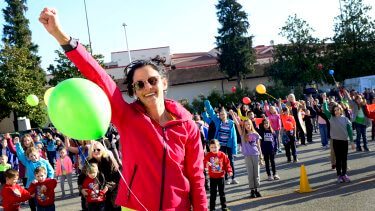Engaging all of the nation’s youth in physical activity and guiding them toward lives in which they are enthusiastically committed to choosing healthy lifestyles is no small feat. SHAPE America’s 50 Million Strong by 2029 commitment seeks to accomplish this through the work of America’s many thousands of health and physical educators. However, the state of health and physical education in US schools remains challenging (SHAPE America, 2016). Many States are cutting or providing waivers for time required for quality health and physical education. Additionally, many have not established policy for children to be active before, during, and after school (SHAPE America, 2016).
In the 2016 Shape of the Nation it was reported that, “although effective physical education and physical activity programs are essential in the formative growth of children, there is a large disparity in state requirements and implementation, affecting children’s abilities to engage in and benefit from these programs” (Shape of the Nation, 2016, p. 4). Given the current status of physical education in America’s schools, for SHAPE America’s ambitious 50 Million Strong commitment to succeed, effective advocacy for quality physical and health education and increased physical activity time in schools is vital.

To create quality and effective health and physical education programs across all schools throughout the nation in the 21st century is clearly going to be a monumental task. And it’s going to be especially difficult in schools where principals and teachers feel pressured to provide as much core content time as possible so that students pass standardized tests. However, it may be possible for physical and health educators and promotors of physical activity to help schools advance their academic mission while simultaneously implementing their own quality programs. But to do this, teachers will need to be equipped with the appropriate information and data in order to craft the right “pitch” to stakeholders.
Making a “pitch” or a case for quality physical and health education and a healthy and active school environment are skills that all physical and health educators should develop. Initiating change begins by creating an argument or persuasive case then presenting it. Typically, this presentation is made to a “stakeholder.” Stakeholders are important because these are the people who can make change happen. Stakeholders vary depending on target goals. Similarly, the substance of one’s argument needs to be different depending on the position and background of each stakeholder.
The key to making change happen in school settings is preparing the “pitch” appropriately. This cannot occur without the use and support of research and data. Research– in contrast to opinion – is data collected using generally agreed-upon scientific research methodologies. It is typically published in peer-reviewed journals. Knowing and understanding research that supports physical and health education, physical activity, and health-related fitness is invaluable. Oftentimes, this research will help build a persuasive case that will hasten change in school settings. It is for example well documented that the cardiovascular fitness levels of youth are positively related to student academic achievement (Castelli et al, 2014). This evidence will help support arguments for regular physical education and increased opportunities for physical activity during the school day.
If physical and health educators want more class time (or in the event time reductions are threatened), they first need to identify the key stakeholders. In this case, the principal may be the first and best stakeholder. School principals usually decide how much time is spent in each subject area: To request additional physical or health education time, data will be needed to support the proposal. Without a persuasive argument, simply asking for more time is unlikely to be successful. But sharing research about the relationships between cardiovascular fitness, physical activity, and academic achievement may make a difference. Even better will be an explanation that shows how this can be done without having a negative impact on others.
Taking this idea of backing up your requests with evidence one step further, is the power behind collecting your own data and using this to tell a story to your stakeholders. National research can be compelling but using local data to tell a story is even more powerful. For example, imagine that you wanted to start an after school program to give youth in your community a spot to be physically active after school. A key issue facing you might be that you don’t have transportation or money to make this happen. How can you raise money to provide this health promoting opportunity for your students?

In this case, a key stakeholder might be your local hospital. To create the best case to convince this stakeholder, you begin by gathering research about the impact of such programs on youth. But in addition, you could add your own data and show the local need and potential benefits. Fitnessgram data could be collected and used to report out your students’ cardiovascular fitness and obesity rates. Additionally, you could collect anecdotal information from selected students about their motivation and intended use of an afterschool program.
It takes time and dedication to create and deliver persuasive presentations that support and advance your physical and health education program. Sometimes you will be successful. Other times not. But with practice and experience you will get better and succeed more often than you fail. And do remember, after securing a “want” from a stakeholder it’s vital to keep collecting and reporting local data so you can tell a positive story of the benefits occurring in your school or classroom. Stakeholders like to be thanked and hear how their assistance has helped.
Often in our busy lives as physical education and health teachers, we are not good at bragging about the awesome things that go one in our classrooms. But advocating for our programs, collecting data to justify them, and continuing that cycle is essential if we are to transform the culture of health and physical education in the school setting. Creating a targeted argument supported by research and data will help in our pursuit of succeeding with #50MillionStrong.
References
Castelli, D.M., Centeio, E.E., Hwang, J., Barcelona, J.M., Glowacki, E.M., Calvert, H.G., & Nicksic, H.M. (2014). The History of Physical Activity and Academic Performance Research: Informing the Future. In Monographs of the Society for Research in Child Development. Retrieved from http://labs.kch.illinois.edu/Research/Labs/neurocognitive-kinesiology/files/Articles/Chapter%207%20-%20Castelli.pdfSHAPE America (2016).
Shape of the Nation: Status of Physical Education in the USA. Retrieved from https://www.shapeamerica.org/advocacy/son/2016/upload/Shape-of-the-Nation-2016_web.pdf
